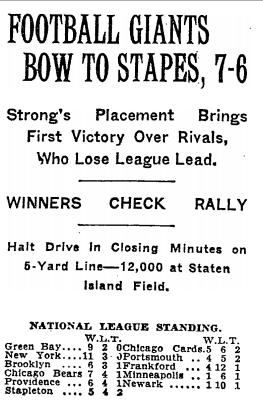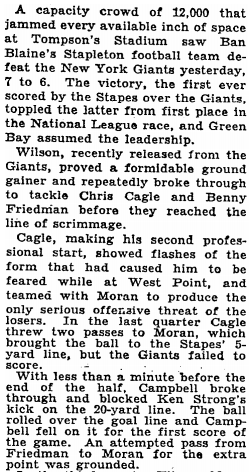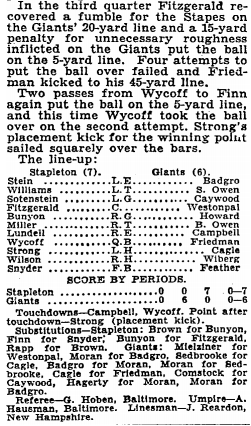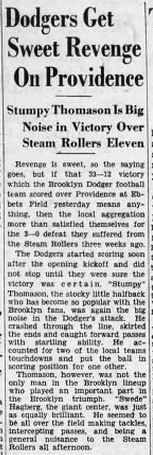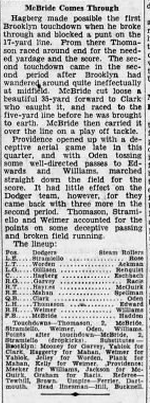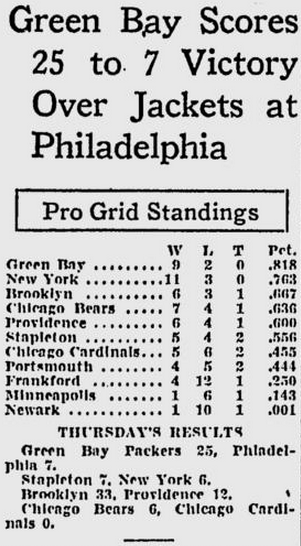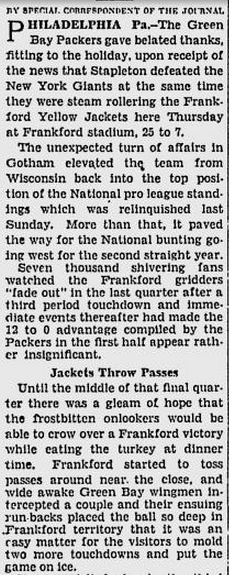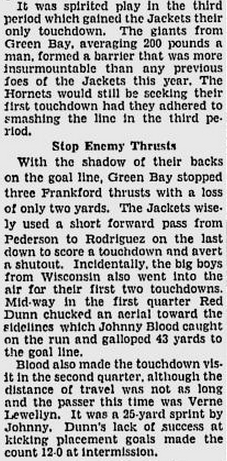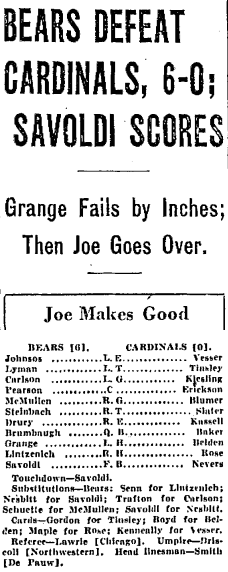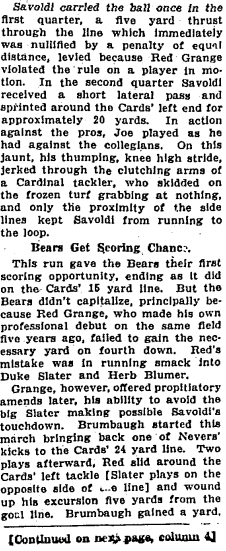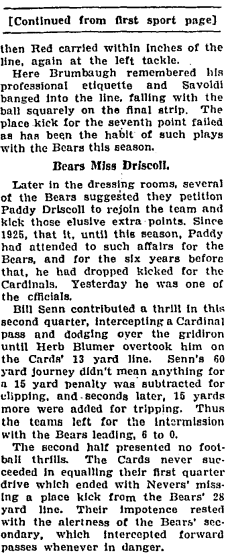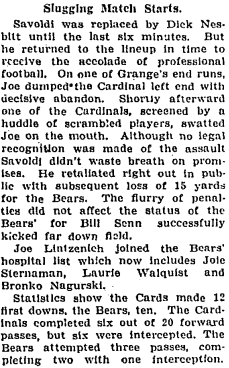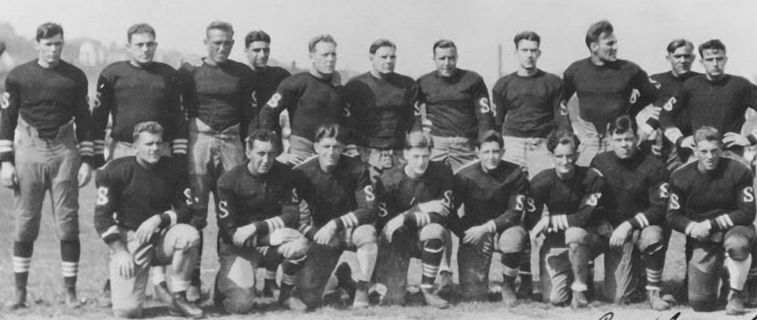Thought we could celebrate the holiday by setting the Wayback Machine for Nov. 27, 1930. Why Nov. 27, 1930, you ask? Oh, why not?
For the record, nine of the NFL’s 11 teams played on that Thanksgiving Day, which wasn’t the least bit unusual. It was, after all, the Depression. If a team could squeeze in an extra game before winter arrived, preferably one against a nearby opponent, it could fill the stadium with both fan bases and possibly break even for the season.
In Portsmouth, Ohio, the Spartans, in their first year in the league, faced the Ironton Tanks, an independent club and their fiercest rival. Spartans-Tanks games had an anarchy all their own. Here’s a link to a piece I wrote about their 1930 Turkey Day battle — memorable in every way — for Sports on Earth last year. (Reader advisory: At one point in the hostilities, a Portsmouth player has his pants torn off.)
But I want to do more with this post than just go over old ground. I want to give you a sense of what a day in the NFL was like in those times. So I’ve gathered newspaper stories about the other four games on Thanksgiving 1930 in case you want to read them. If you went to the newsstand the next day, this is the coverage you would have found in The New York Times, Brooklyn Eagle, Milwaukee Journal and Chicago Tribune.
Two of the games were in New York. The first, at Thompson’s Stadium on Staten Island, pitted the Giants against the Stapletons. The Giants, who were leading the league with an 11-2 record, had Benny Friedman, the greatest of the early passers. But the Stapes, 4-4-2 coming in, had a Hall of Fame back of their own: Ken Strong (who moved to the Giants after the Staten Island franchise folded and spent most of his career with them). The Times’ account:
The “Wilson” mentioned in the story, by the way, was Mule Wilson, one of the Stapletons’ running backs. Can you imagine leaving that out of the play-by-play – a fabulous name like Mule? Of course, Moran’s first name, Hap, also was omitted. He, too, was a back — for the Giants.
The difference in the game, as you read, was that the Stapes made their one PAT try and the Giants missed theirs. But the Giants, interestingly, didn’t attempt a kick. Instead, the Times reported, their “pass from Friedman to Moran for the extra point was grounded [meaning incomplete].” Teams sometimes did that back then. What would have been nice is if the paper had explained the Giants’ strategy. Was the field too torn up for a dropkick? Was there a problem with the snap that forced Friedman, the Giants’ primary kicker, to throw the ball instead? We’ll never know. But it proved incredibly costly.
The second game in New York was between the Brooklyn Dodgers and Providence Steam Roller, the 1928 champs, at Ebbets Field. As with the Times, the Eagle’s coverage was less than exhaustive: five paragraphs plus a box score that provided the starting lineups, scoring summary, substitutions and officiating crew. Note that only three officials worked these games: a referee, umpire and head linesman. Think a few penalties — if not felonies — might have gone unnoticed?
So in the Giants game we have Mule and Hap, and in this one we have Stumpy (Thomason, “the stocky little halfback who has become so popular with the Brooklyn fans”). What can I tell ya? They were big on nicknames in the ’30s. One of the reasons the Dodgers won by such a large margin — 21, which was a sizable spread in the NFL’s dead-ball era — is that the Steam Roller were playing shorthanded. After dropping out of the race, they’d released five players to reduce payroll (and Portsmouth happily signed them to load up for the Ironton grudge match).
Let’s move on to Philadelphia — and the Frankford Yellow Jackets-Green Bay Packers matchup. The Packers were a veritable all-star team with future Hall of Famers in the backfield (quarterback Arnie Herber, back Johnny Blood) and the line (tackle Cal Hubbard, guard Mike Michalske). They also had a center, Jug Earp, who was related to Wyatt Earp, the famous lawman (just in case there was any trouble).
The Frankford franchise, on the other hand, was in its death throes — yet another victim of the hard economic times. The Yellow Jackets had won the championship four years earlier and were one of the strongest teams in the ’20s, but 1931 would be their last season in the league (as it would for the Steam Roller).
This was a huge victory for the Packers. Not only did it stop a two-game skid, it enabled them — because of the Giants’ loss — to reclaim first place. They went on to win their second of three straight titles (an NFL record later tied by Vince Lombardi’s Packers in the ’60s). Despite their success, though, it looks like the Journal hired a stringer to cover the game in Philly. I’m guessing the paper didn’t have the healthiest travel budget the year after the stock market crashed.
My favorite passage in the story: “With the wind at their backs the Jackets kicked far into Green Bay territory. One of the many fumbles, all of which can be readily excused because of frozen fingers, occurred at this time.”
It wasn’t unheard of for players to wear gloves in the 1930s — even if some of them did disdain helmets. But it appears everybody toughed it out in the Packers-Yellow Jackets game. Thus, the “many fumbles.”
We finish this Day in the Life of the NFL at Wrigley Field, where the Bears and Cardinals collided with Chicago bragging rights at stake. The game is particularly notable because of a late addition to the Bears roster: fullback Joe Savoldi, who had been booted out of Notre Dame in midseason after it was discovered he was married. By week’s end, the Bears were $1,000 poorer — the fine they were assessed for signing a player before his college class had graduated. The Tribune’s take:
You’ll love this: The Wilfrid Smith who wrote the game story and the “Smith [De Pauw]” who served as the head linesman are the same person. A number of sportswriters in that era double-dipped as officials — and would sit in the press box afterward, still wearing their zebra outfits, and type their deathless prose. (The linesman in the Giants game was “J. Reardon.” That would be Jack Reardon of the Times. He may well have covered the game, too, but we can’t be 100 percent sure because the story didn’t have a byline.)
Smith, who also played some tackle in the NFL with the Cardinals and three other clubs, was one of the best football writers of his generation — knowledgeable, instructive and funny. Wasn’t it classic how he described Savoldi’s touchdown?
Red [Grange, the Bears’ halfback] carried within inches of the [goal] line. . . . Here, [quarterback Carl] Brumbaugh remembered his professional etiquette and Savoldi banged into the line, falling with the ball squarely on the final strip[e].
Did you catch, too, that the Cardinals completed six passes to their own receivers and six to the Bears? Putting the ball in the air could be a risky proposition in those days, much like plane travel.
So ends our field trip to Thanksgiving 1930. According to my calculations, the attendance at the five games was 37,500 — about half the capacity of AT&T Stadium, where the Cowboys will host the Eagles today. Eighty-four years later, the Stapes, Dodgers, Steam Roller and Yellow Jackets no longer exist, the Spartans have moved to Detroit and become the Lions and the Cardinals have relocated to Arizona after a stop in St. Louis.
Even worse, there’s nobody in the league named Mule or Hap or Stumpy.

